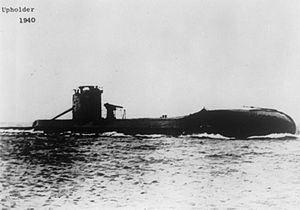Name HMS Upholder Commissioned 31 October 1940 Fate sunk 14 April 1942 Launched 8 July 1940 Draft 4.62 m Builder Vickers-Armstrongs | Laid down 30 October 1939 Construction started 30 October 1939 Length 58 m Beam 4.8 m | |
 | ||
Displacement Surfaced – 540 tons standard, 630 tons full loadSubmerged – 730 tons | ||
HMS Upholder (P37) was a Royal Navy U-class submarine built by Vickers-Armstrong at Barrow-in-Furness. She was laid down on 30 October 1939, launched on 8 July 1940 by Mrs. Doris Thompson, wife of a director of the builders. The submarine was commissioned on 31 October 1940. She was one of four U-class submarines which had two external torpedo tubes at the bows in addition to the 4 internal ones fitted to all boats. They were excluded from the other boats because they interfered with depth-keeping at periscope depth.
Contents
Career
She was commanded for her entire career by Lieutenant-Commander Malcolm David Wanklyn, and became the most successful British submarine of the Second World War. After a working up period, she left for Malta on 10 December 1940 and was attached to the 10th Submarine Flotilla based there. She completed 24 patrols, sinking 93,031 tons of enemy shipping including the Maestrale-class destroyer Libeccio after the Battle of the Duisburg Convoy, two submarines (the Tricheco and the Saint Bon), three troopships, six cargo ships, an auxiliary ship and an auxiliary minesweeper. Wanklyn was awarded the Victoria Cross for a patrol in her in 1941, which included an attack on a particularly well-defended convoy on 24 May 1941 in which Upholder sank the 17,879 GRT Italian troop ship SS Conte Rosso. On 28 July 1941 she damaged the Italian cruiser Giuseppe Garibaldi. On 18 September 1941 she sank two troopships within hours of each other: the sister ships MS Neptunia (19,475 GRT) and MS Oceania (19,507 GRT).
Upholder also damaged the Italian light cruiser Giuseppe Garibaldi (9500 tons), the German freighter Duisburg (7,389 GRT), the French tanker Capitaine Damiani (4,818 GRT), the Italian freighters Dandolo (4,964 GRT) and Sirio (5,223 GRT) and destroyed the wreck of the German freighter Arta (2,425 GRT) already grounded after the battle of Tarigo convoy.
Sinking
Upholder was lost with all hands on her 25th patrol, which was to have been her last before she returned to England. She left for patrol on 6 April 1942 and became overdue on 14 April. On 12 April she was ordered, with HMS Urge and HMS Thrasher to form a patrol line to intercept a convoy, but it is not known whether she received the signal.
Theories about her loss
The most likely explanation for her loss is that after being spotted by a reconnaissance seaplane, she fell victim to depth charges dropped by the Italian Orsa-class torpedo boat Pegaso northeast of Tripoli on 14 April 1942 in the position 34°47′N 15°55′E, although no debris was seen on the surface. The attack was 100 miles northeast from Wanklyn's patrol area and he may have changed position to find more targets. It is also possible that the submarine was sunk by a mine on 11 April 1942 near Tripoli, when a submarine was reported close to a minefield. A third and less likely theory came from an alleged air and surface attack on a submarine contact by German aircraft and the escort of a convoy on 14 April off Misrata, but no official Axis record of this action was found after the end of World War II.
A more recent research carried out by Italian naval specialist Francesco Mattesini points to a German aerial patrol supporting the same convoy, comprising two Dornier Do 17 and two Messerschmitt Bf 110 aircraft, that attacked an underwater contact with bombs two hours before the Pegaso incident. The author also asserts that the seaplane crew was unsure if the target they pinpointed to Pegaso was a submarine or a school of dolphins. Mattesini admits the possibility that Pegaso could have finished off the submarine previously damaged by the German aircraft.
Tribute
When, on 22 August 1942, the Admiralty announced her loss, the communiqué carried with it an unusual tribute to Wanklyn and his men: "It is seldom proper for Their Lordships to draw distinction between different services rendered in the course of naval duty, but they take this opportunity of singling out those of HMS Upholder, under the command of Lt.Cdr. David Wanklyn, for special mention. She was long employed against enemy communications in the Central Mediterranean, and she became noted for the uniformly high quality of her services in that arduous and dangerous duty. Such was the standard of skill and daring set by Lt.Cdr. Wanklyn and the officers and men under him that they and their ship became an inspiration not only to their own flotilla, but to the Fleet of which it was a part and to Malta, where for so long HMS Upholder was based. The ship and her company are gone, but the example and inspiration remain." In all, Upholder was credited with having sunk 97,000 tons of enemy shipping, in addition to three U-boats and one destroyer.
Quoted by Admiral of the Fleet, The Lord Fieldhouse GCB, GCE probably during the Falklands War: "I can do no better than repeat the unique message following the sinking of HMS Upholder on April 14th 1942 : 'The ship and her company are gone but the example and inspiration remain'"
